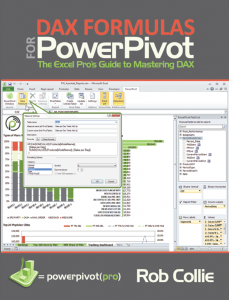 I’ve known Rob Collie (blog | @powerpivotpro) for over two years now, ever since he accosted me at TechEd in 2010. Since then we’ve met up at some SQL Saturdays, the 2010 PASS Summit, and we even collaborated on the computing power and hard dollar costs adjusted for inflation. And by “collaborated” I mean “I emailed Rob and asked him to show me what to do”. And then he did. True story.
I’ve known Rob Collie (blog | @powerpivotpro) for over two years now, ever since he accosted me at TechEd in 2010. Since then we’ve met up at some SQL Saturdays, the 2010 PASS Summit, and we even collaborated on the computing power and hard dollar costs adjusted for inflation. And by “collaborated” I mean “I emailed Rob and asked him to show me what to do”. And then he did. True story.
When I read that post on Moore’s Law again it made more sense to me this time. The reason why is because I just got done reading his most amazing book: DAX Formulas for PowerPivot: The Excel Pro’s Guide to Mastering DAX
When I opened the book to flip through the pages I will admit I was slightly disappointed in what I first saw: a bunch of formulas like CALCULATE(), DATEADD(), and COUNT(X). I thought “Oh, no, Rob has gone and written a book like all the other tech books out there, full of formulas and a desire to be like a textbook that it is likely never going to be.” Knowing Rob this surprised me a bit and since I had already spent my money I figured I might as well start reading it anyway.
I started reading his while sipping on my coffee this past Sunday morning. I was done with the book before lunch. Not because it was a short read, but because I just could not put it down.
Rob walks you through what is essentially the training program he uses with clients that want to know how to use PowerPivot. He gives you step by step examples and ties everything back to clearly defined use cases. He mixes in some anecdotal stories along the way, too. Rob worked at Microsoft for many years and as a result he has many, many stories to share. I think the one about Steve Ballmer was my favorite.
Not only does Rob walk you through formulas he also provides specific use cases and shows you the pitfalls that he has stumbled upon through the years. In short you get years of data analysis experience at your disposal in just a few hours of learning. Rob even has an “intermission” in his book where he tells you to “take stock of your new powers”, and that you could close the book now and still be four to five times better than you were when you started. I believe him.
Rob did something that I know other authors dream about: he wrote a technical book and made it seem human. He has an uncanny ability to communicate his thoughts and explanations in terms that others can understand. This is how technical books should be written.
I can’t recommend this book enough. It represents the future for data professionals. The future isn’t about racking servers. It’s about getting people access to the data they want, in a meaningful way, and quickly. As a DBA you are already very familiar with data: how it moves, how it’s stored, how it should look. Take those skills and start learning how to apply them in a different manner.
Soon you will find your skills in demand in a similar manner to Rob. There is a reason he is so busy these days.
I’ve added a new shelf to my library named “Data Analytics and Insights” and placed Rob’s book there along with a few others that I think you will find useful.
Go have a look at your future.


Thanks for the review, Tom. Might add this to my reading list.